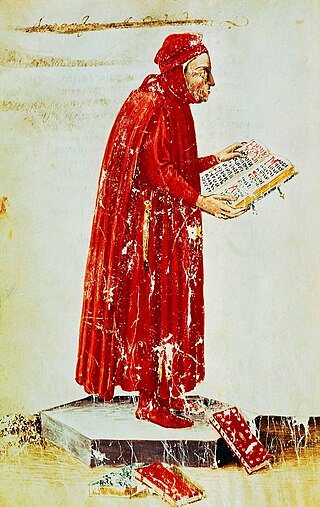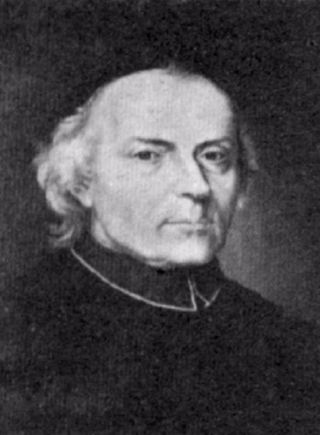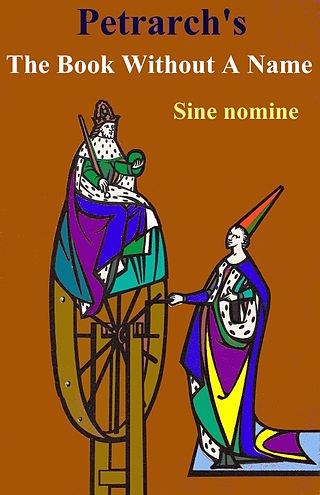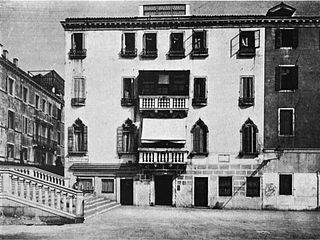Related Research Articles

Giovanni Boccaccio was an Italian writer, poet, correspondent of Petrarch, and an important Renaissance humanist. Born in the town of Certaldo, he became so well known as a writer that he was sometimes simply known as "the Certaldese" and one of the most important figures in the European literary panorama of the fourteenth century. Some scholars define him as the greatest European prose writer of his time, a versatile writer who amalgamated different literary trends and genres, making them converge in original works, thanks to a creative activity exercised under the banner of experimentalism.

Francesco Petrarca, commonly anglicized as Petrarch, was a scholar and poet of early Renaissance Italy, and one of the earliest humanists.

Coluccio Salutati was an Italian humanist and notary, and one of the most important political and cultural leaders of Renaissance Florence; as chancellor of the Republic and its most prominent voice, he was effectively the permanent secretary of state in the generation before the rise of the Medici.

ManuelChrysoloras was a Byzantine Greek classical scholar, humanist, philosopher, professor, and translator of ancient Greek texts during the Renaissance. Serving as the ambassador for the Byzantine emperor Manuel II Palaiologos in medieval Italy, he became a renowned teacher of Greek literature and history in the republics of Florence and Venice, and today he's widely regarded as a pioneer in the introduction of ancient Greek literature to Western Europe during the Late Middle Ages.

Lodovico Antonio Muratori was an Italian Catholic priest, notable as historian and a leading scholar of his age, and for his discovery of the Muratorian fragment, the earliest known list of New Testament books.

Antiqua is a style of typeface used to mimic styles of handwriting or calligraphy common during the 15th and 16th centuries. Letters are designed to flow and strokes connect together in a continuous fashion; in this way it is often contrasted with Fraktur-style typefaces where the individual strokes are broken apart. The two typefaces were used alongside each other in the germanophone world, with the Antiqua–Fraktur dispute often dividing along ideological or political lines. After the mid-20th century, Fraktur fell out of favor and Antiqua-based typefaces became the official standard.

De Viris Illustribus, meaning "concerning illustrious men", represents a genre of literature which evolved during the Italian Renaissance in imitation of the exemplary literature of Ancient Rome. It inspired the widespread commissioning of groups of matching portraits of famous men from history to serve as moral role models.

Arquà Petrarca is a town and municipality (comune) in northeastern Italy, in the Veneto region, in the province of Padua. As of 2007 the estimated population of Arquà Petrarca was 1,835. The town is part of the association of the most beautiful villages in Italy, and it has been awarded the Bandiera arancione award for excellence in tourism, hospitality and the environment.

The Euganean Hills are a group of hills of volcanic origin that rise to heights of 300 to 600 m from the Padovan-Venetian plain a few km south of Padua. The Colli Euganei form the first Regional park established in the Veneto (1989), enclosing fifteen towns and eighty one hills.

The House of Carrara or Carraresi (da Carrara) was an important family of northern Italy in the 12th to 15th centuries. The family held the title of Lords of Padua from 1318 to 1405.
Giovanni Gioseffo dal Sole was an Italian painter and engraver from Bologna, active in the late-Baroque period. Upon the death of Carlo Cignani, Gioseffo dal Sole became among the most prominent painters in Bologna, described as the Guido Moderno.
Pier Paolo Vergerio was an Italian humanist, statesman, pedagogist and canon lawyer.

The Liber sine nomine is a collection of nineteen personal letters written in Latin by the fourteenth century Italian poet and Renaissance humanist Petrarch. The letters being harshly critical of the Avignon papacy, they were withheld from the larger collection of his Epistolae familiares and assembled in a separate book. In this fashion, Petrarch reasoned, a reader could throw away this collection, and the other letters to friends could be preserved for posterity.

Philippe de Cabassole or Philippe de Cabassoles (1305–1372), the Bishop of Cavaillon, Seigneur of Vaucluse, was the great protector of Renaissance poet Francesco Petrarch.

Palazzo Mangiapane or Palace of Two Towers or Palazzo Navager is a Gothic style palace located on the Riva degli Schiavoni #4145 in the sestiere of Castello, Venice, adjacent to the Ponte del Sepolcro, previously called the Bridge of Ca'Navager. It is best known for being the home, for about five years, of the poet Petrarch.

Giacomo or Jacopo d'Angelo, better known by his Latin name Jacobus Angelus, was an Italian classical scholar, humanist, and translator of ancient Greek texts during the Renaissance. Named for the village of Scarperia in the Mugello in the Republic of Florence, he traveled to Venice where the Byzantine emperor Manuel II Palaiologos' ambassador Manuel Chrysoloras was teaching Greek, the first scholar to hold such course in medieval Italy.

Humanist minuscule is a handwriting or style of script that was invented in secular circles in Italy, at the beginning of the fifteenth century. "Few periods in Western history have produced writing of such great beauty", observes the art historian Millard Meiss. The new hand was based on Carolingian minuscule, which Renaissance humanists, obsessed with the revival of antiquity and their role as its inheritors, took to be ancient Roman:
[W]hen they handled manuscript books copied by eleventh- and twelfth-century scribes, Quattrocento literati thought they were looking at texts that came right out of the bookshops of ancient Rome".
Malatesta IV Malatesta was an Italian condottiero, poet and lord of Pesaro, Fossombrone, Gradara, Jesi, Narni and other fiefs in Italy.

Francesco I da Carrara, called il Vecchio, was Lord of Padua from 1350 to 1388.
Albinia Catherine de la Mare,, known in print as A.C. de la Mare and informally as “Tilly”, was an English librarian and palaeographer who specialised in Italian Renaissance manuscripts.
References
- Encyclopedia of World Biography . McGraw Hill. 1998. ISBN 9780787625573.
- Wilkins, Ernest H. (1961). Life of Petrarch.